Radioactivity
The phenomenon of spontaneous emission of certain kind of invisible radiation by certain substance is called Radioactivity. The substances which emit such radiation is called
Radioactive substance. It was discovered accidentally by the French Scientist Henry Becquerel.
Radiopharmaceuticals are used in medicines. It is used to treat cancerous tumors, to diagnose thyroid disorders and other metabolic disorders including brain function.
Radioactive Rays
Radioactive radiations are composed of three important rays α, β and δ which differ very much in their nature and properties.
α-rays
These rays or particles are positively charged. It consists of two unit positive charge and has a mass which is nearly four times that of hydrogen atom. These are heavy, slow moving and their penetrtion power is slow. These rays ionise the gas through which they pass.
During the emission of a-particle from a radioactive element, atomic number decreases by 2 unit and mass number decrease by 4 units.

β-rays
These rays or particles are negatively charged. They have negligible mass. These having smaller mass, higher speed and thus β-particles are much more penetrting than aparticle. They have lower ionising power than α-rays.
During the emission of β-particle from a radioactive element, atomic number increases by 1 unit and there is no change in mass number.
For example :

γ-rays :
These rays are neutral i.e. do not carrying charge. The particle of these rays has negligible mass. As they do not have any mass, their ionising power is also very poor. They not affected by magnetic field and are having the speed of light.
Read and Learn More Pharmaceutical Inorganic Chemistry Notes
Isotopes
Atoms of an element which have the same atomic number but have different mass number are called Isotopes, in other words, isotopes are atoms of the same element whose nuclei contain the same number of protons but different number of neutrons.
When the radioactive isotopes undergo nuclear reactions and they produce α, β and γ particles. The original nuclide is called the parent and the product is termed as daughter nuclide.
This phenomenon of nuclear changes is termed as disintegration or radioactive decay.
Radioactive Decay
According to the law of Radioactive Decay, the quantity of a radioelement which disappears in unit time (rate of disintegration) is directly proportional to the amount present. It is independent of temperature, so its energy of activation is zero.
Various forms of equation for radioactive decay are

Where λ, is a constant, and is known as decay or disintegration constant. Integrating the equation i)

C is the constant of integration and log N stands for logeN. Since the number of atoms of the radioactive substance present initially i.e. t = 0 is N0
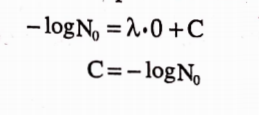
Substituting the value of integration constant
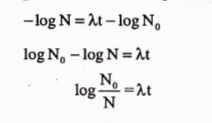
Converting log to the base e to the base 10, we get :
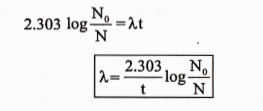
Nt= Nvunber of atoms that nucleid present after time t.
N0 = Initial number of atoms of the nucleid at time 0.
λ = Decay constant
This equation is similar to that of the first order reaction, hence it is seen that radioactive disintegration are example of first order reactions.
Units Of Radioactivity
Units of Radioactivity is Curie. Its symbol is Ci or C. It refers to the activity of one gram of radioactive material and is equal to 3.7 x1010 disintegration per second (dps).
1 Curie = 3.7 x 1010 dps
The millicurie and micro curie are equal to 10-3 or 10-6 respectively.
1 Millicurie = 3.7 x 107 dps
1 Microcurie = 3.7 x 104 dps
But nowadays, the unit curie is replaced by Rutherford (Rd).
Rutherford (Rd) is defined as the amount of a radioactive substance which undergoes 106dps.
Roentagen (R). it is the unit of exposure, 1R = 2.58 x 10-4CKg-1 (C = A Coluomb)
RAD: It is the unit of absorbed dose, 1 rad = 10-2JKg-1
However in SI system,
Bacquerel (Bq) : it is defined as one disintegration per second.
1 Bq = 1 disintegration per second
106Bq=1 rd
3.7×1010 Bq=1c
Half-Life Of Radioelement
The half-life period is defined as the time required for a radioactive isotope to decay to one half of its initial value. It is denoted by t1/2

Where λ is disintegration constant. Each radioactive isotope has its own characteristic of half-life. Shorter the half-life period of an element, greater is the number of disintegrating atoms and hence greater is its radioactivity.
The half-life periods or half lives of different radioelements vary widely ranging from fraction of seconds to millions of years.
Half-lives for various radionucleides vary considerably e.g. Polonium- 122 has half-life of 3 x10-7 seconds, uranium 238 has 4.5 x104 years.
Average Half-Life Period
The reciprocal of the radioactive constant or decay constant is called average half life period. It is denoted by Τ (tau).

Example 1: Calculate the half-life period of an isotope if its disintegration constant is 1.237 x 10-4 year-1.
Solution.

Example 2: The half-life period of a radioactive element is 2.5 days? What is the value of decay constant (λ,) in mm-1?
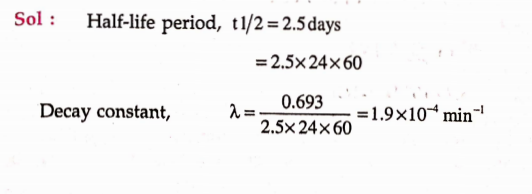
Example 3: A radioactive substance decay at such a rate that after 46 days only 0.25 of its original amount is left. Calculate the disintegration constant and half-life period?
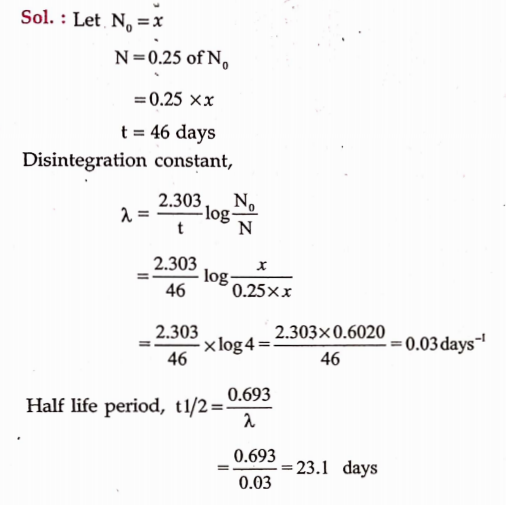
Measurement Of Radioactivity
To measure the radiations ofalpha, beta and gamma rays many techniques involving detection and counting of individual particles or photons have been available. It include Ionisation Chamber, Proportional counter, Geiger-Muller counter.
Ionisation chamber: An ionisation chamber consists of chamber filled with gas and fitted with two electrodes kept at different electrical potentials and a measuring device to indicate the flow of electric current.
The fill gas can be Ar, He, air etc. These available in various size and shapes. They have poor resolution due to large number of charge carriers. They are operated in current mode.
Proportional counter: If the electric field gradient between the anode & cathode is increased by increasing the applied voltage, the electrons produced in the primary ionisation further ionise the gas molecule e.g. the number of ion pair is multiplied.
For each primary electron liberated, ‘ a large number of additional electrons are liberated, the current pulse through electrical current is greatly amplified.
In a certain original number of ion pairs. Proportional counters operate in this voltage region. They are usually operated in pulse mode and are used in the form of gas filled or gas flow counters for a, b and fission frequent counting.
The most common file pass is “P-10” consisting of 90% Ar and 10% methane. The energy resolution of the proportional counter is in the range of 5-10%.

Geiger-Muller Counter: It is one of the oldest radiation detector types in existence, having been introduced by Geiger and Muller in 1928. It is referred to as G-M counter or simply tube.
The simplicity, low cost and of ease of operation of these detectors have lead to their continued use to the present time. They can detect a, P and y radiations. It consists of a cylinder made up of stainless steel or glass coated with silver on the inner side which acts as cathode.
Coaxially inside the tube a mounted fine were works as an anode. It is having the mixture of ionising gas which contain a small proportion quenching vapour.
The function of quenching vapour are i) to prevent the false pulse, ii) to absorb the photons emitted by excited atoms and molecule returning to their ground state.
Chlorine, bromine, ethyl alcohol and ethyl formate are commonly used qenching agents. Radiation when enters the tube through a thin section of outer wall causes ionisation of atoms of the gas.
When a high voltage is maintained between two electrodes, the electrons and charged ions are attracted by the anode and cathode respectively. Each particle of radiation produces a brief flow or pulse of current which can be recorded by a scalar.
Scintillation Detectors
Scintillation detectors rely on theatomic ormolecular excitation produced. Deexcitation then results in the emission of light, a process known as fluorescence.
This light then act as a detectable signal. It consists of a cell, a photomultiplier tube coupled with phosphar or flour to convert scintillations into electrical pulses, an amplifier and a scalar.
Both inorganic and organic scintillations can be used as detector. There are two main types of scintillator :
Inorganic, such as Sodium Iodide: Single crystals of Nal, doped with an activator such as Thallium to modify the energy levels which are used to form detectors.
They are insulators and have a wide gap between the valence band and conduction band suitable activators are used to create excited states which decay by emission of light in the visible range. Other scintillation like CsI (TI), CsI(Na), Hi I (Er), BaF2.
Organic Scintillator: It is used for simple α and β counting with 100% efficacy. Anthrene have high scintillation efficacy and stilbene low scintillation efficacy.
It suffer from the limitation of poor energy resolution.

Major Uses Of Radioisotopes
Storage, Handling And Precautions Of Radioactive Material
A care should be taken to protect people and personal from harmful radiation during handling and storage of radioactive material emits.
The following precautions are taken while working with radiodetectors, radio assays, traces experiments, manufacturing or handling of radioactive materials.
- These materials should be handled with forceps or sutiable instruments and direct contact should be avoided.
- Any substance which is taken internally (foods, drinks, smokes etc.) should not be carried in laboratory where radioactive materials are used.
- Sufficient protective clothing or shielding must be used while handling the materials.
- Radioactive materials should be kept in suitable labelled containers shield by lead bricks and preferably in remote corner.
- Areas where radioactive materials are used or stored should be monitored constantly (tested regulary for radioactivity).
- The final disposed of radioactive material should be done with great care to animals and environment.
Radioopque Contrast Media
Radioopaque contrast media are the chemical compounds having the capacity to absorb and block the passage of x-rays. So they are opaque to x-ray examination.
They are used as a diagnostic aid in radiology which emits x-rays. They can pass through soft tissues of the body but are observed at hard tissues (bone).
The ray produces a black spot on photographic plate by forming complex with silver bromide.
These rays does not form a bright spot of the similar shape as that of x-ray observing object is formed.
X-rays are electromagnetic radiations of short wavelength and have high penetrating power.
Radioopaque agents are typically iodine or barium compounds and are used for x-ray examinations of the kidney, liver, blood vessels, heart and brain.
Although they do not have the highest atomic numbers/they are the most easily incoorporated into molecules exhibiting low toxicity. They become concentrated in the organ to be studied.
Radiopharmaceuticals
Various radioopaque contrast media are used in the x-ray examination of gastro intestinal tract, gall bladder and bile duct, kidney and uretar, fallopian tubes, liver, blood vessels heart and brainets.
Barium Sulphate
Formula: BaSO4
Mol. Wt: 233.4
Preparation
In nature it is found as barite; also as heavy spar.
It may be prepared by adding any soluble sulphate to a soluble barium salt. For example addition of sodium sulphate to a solution of barium chloride precipitates barium sulphate.
![]()
Barium chloride on treatment with sulphuric acid causes precipitation of Barium sulphate.

Physical Properties
It is fine, heavy, white, odourless, tasteless, bulky powder free from gritty particles. It is practically insoluble in water, in organic solvents and in dilute solutions of acid and alkalies.
The bulky is free from gritty particles. It does not have any toxic effects to man and the environment.
Chemical Properties
Barium sulphate on treatment with cone, sulphuric acid results in the formation of bisulphate salt.

Uses
- It is used as a radiopaque contrast media for the x-ray examination of the git tract.
- Barium ion stimulates smooth muscles causing vomiting, severe cramps, diarrhoea and haemorrhage.
- It is used primarily as a whitening agent and as an insoluble support in industrial applications.
Radiopharmaceuticals Short Answer Questions
Question. 1. Define Radioactivity.
Answer. The spontaneous emission of certain radiations like α, β and γ-rays is known as radioactivity.
Question.2. t1/2 of radioactive element is 100 seconds? What is the value of its disintegration constant? •
Answer:
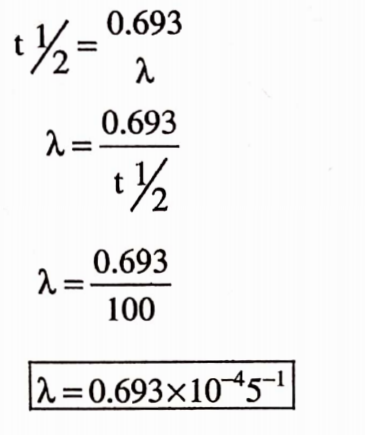
Question.3. In the sequence A→B→C→D. What is relationship between A and D?
Anwer: They are isotopes
Question.4. What is meant by rate of radioactive decay? Give general formula of decay constant?
Answer.
Rate at which radioactive element disintegrate is called rate of radioactive decay.

Where N0 is initial amount of radioactive substance.
Nt is final amount of radioactive substance.
Question.5. Differentiate between a, P and y rays?
Answer:
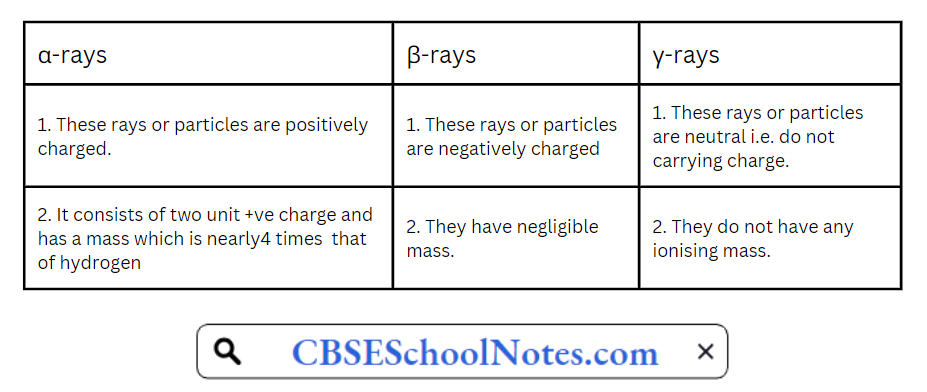
Question.6. Define Curie?
Answer. It refers to the activity of one gram of radioactive material and is equal to 3.7×1010 disintegration per second. Its unit of radioactivity.
1 Curie = 3.7xl010 dps
Question.7. Define Half life? How is it denoted?
Answer. Half life period is defined as the time required for a radioactive isotope to decay to one half of its initial value.
It is denoted by t1/2.
t1/2=0.693/λ
Where λ is disintegration constant.
Question.8. Give two examples of radioisotopes?
Answer.
- Calcium 47
- Cesium 137
- Chromium 51
- Iodine 123
Question.9. What do you understand by the term Radioopaque contrast media?
Answer. Radioopaque contrast media are the chemical compounds which are having the capacity to absorb or block the passage of X-rays.
Question.10. Give two examples of Radioopaque agents?
Answer. Barium sulphate And Iodine
Question. 11 What are the uses of Radioopaque contrast media?
Answer Radioopaque contrast media are used in the x-ray examination of g.i. tract, gall bladder, bile duct, kidney and fallopian tubes.
Question.12. How is Barium sulphate prepared?
Answer. Barium sulphate can be prepared by adding any soluble sulphate to a soluble barium salt.
For example:- Addition of sodium sulphate to a solution of BaCl2 precipitates barium sulphate.

Radiopharmaceuticals Fill In The Blanks
1. Radioactivity undergo …………………..reaction.
Answer: Spontaneous
2. An alpha particle carries…………….
Answer: 2 unit positive charge
3. An beta particle is……………… charged.
Answer: Negatively
4. Isotopes have the same ………..but different……………….
Answer: Atomic number, mass number
5. The order of reaction of radioactive decay is …………………
Answer: First order
6. The t l/2 of a radioactive substance is 100 second, its X is……………………
Answer: 6.93 x lO-sec-1
7. …………………… is used for the measurement of radioactivity.
Answer: Geiger-Muller counter
8. …………………..is gas filled detector.
Answer: Ionisation chamber, proportional counter
9. The time required by given amount of the element to decay to one half of its initial value is known as…………….
Answer: Half-life
10. P-10 gas is a mixture of…………..and………….
Answer: 90% Argon & 10% methane
Radiopharmaceuticals True Or False Statement
1. Radioactive decay is first-order reaction.
Answer: True
2. Alpha particles are identical with helium nuclei.
Answer: True
3. Rate of disintegration is inversely proportional to the amount present.
Answer: False
4. (5-rays have highest penetrating power as compared to a, y rays.
Answer: False
5. Radioactivity is a spontaneous process.
Answer: True
6. Geiger-Muller counter cannot detect a, (5 and y-radiations.
Answer: False
7. Radioopaque contrast media do not need any x-ray examination.
Answer: False
Radiopharmaceuticals Multiple Choice Questions
1. Radioactivity was discovered firstly by>
- Henry Becquerel
- Rutherford
- J.J. Thomson
- Madame Curie
Answer: Henry Becquerel
2. The unit of radioactivity is:-
- Curie
- Rutherford
- Ohms
- Both a) and b)
Answer: Curie, Rutherford
3. A device used for the measurement of radioactivitv is a
- Mass spectrophotometer
- Cyclotron
- Nuclear reactor
- G.M. Counter
Answer: G.M. Counter
4. Radioactivity is due to
- Stable electronic configuration
- Unstable electronic configuration
- Stable nucleus
- Unstable nucleus
Answer: Unstable nucleus
5. When a radioactive nucleus emits an a particle, the mass number of the atom
- Increases and its atomic number decrease
- Decrease and its atomic number decrease
- Decrease and its atomic number increase
- Remain the same
Answer: Decrease and its atomic number decrease
6. Which isotope on bombardment with a-partide mil have 17/8 O and 1/1H?
![]()
Answer: b)
7. The decay of a radioactive element follows first order kinetics. As a result of:-
- The half life period= a constant k where k is the decay constant
- The rate of decay is independent of temperature
- The rate can be altered by changing chemical conditions
- None of the above
Answer: The rate of decay is independent of temperature
8. Which of the following is correct?
- Radioactivity is a statistical process
- Radioactivity is a spontaneous process
- Radioactivity is characteristics of some elements
- Both b) and c) are true
Answer: Both b) and c) are true
9. Radioactive decay is a reaction of
- First order
- Second order
- Third order
- Zero-order
Answer: First order
10. a-rays have
- +ve charge
- -ve charge
- no charge
- Sometimes +ve and sometimes -ve
Answer: +ve charge
11. Gamma rays have
- High penetrating power than a and P
- No penetrating power
- Less penetrating power than a and (3
- None of the above
Answer: High penetrating power than a and P
12. Alpha rav consists of a stream of
- H+
- He2+
- Only electrons
- Only neutrons
Answer: He2+
13. The radiation which has highest penetrating power is
- α-rays
- β-rays
- γ-rays
- None of the above
Answer: γ-rays
14. Isotopes are having
- Same atomic number but different mass number
- Same atomic number and same mass number
- Atomic number increases
- None of the above
Answer: Same atomic number but different mass number
15. When the difference between mass number and atomic number of atoms of two or more elements are same, the atoms are known as
- Isotopes
- Isobars .
- Isotones
- Nuclear isomers
Answer: Isotones
16. Half-life period of a radioactive is calculated by:-

Answer: a)
17. The atomic number of the element is equal to the
- Number of protons
- Number of neutrons
- Slim of number of protons & neutrons
- None of the above
Answer: Number of protons
18. P- rays are
- +vely charged
- -vely charged
- Neutral
- None of the above
Answer: -vely charged
19. During the emission of a P-particle:-
- Atomic number increases by 1 unit & there is no change in the mass number
- Atomic number decreases by 2 unit, mass number decreases by 4 unit
- Atomic number and mass number remains same
- Atomic number and mass number both get increased
Answer: Atomic number and mass number remains same
20. P-10 gas is
- Mixture of 10% argon and 90% methane
- Mixture of 90% argon and 10% air
- Mixture of 90% argon and 10% oxygen
- Mixture of 90% argon and 10% methane
Answer. mixture of 90% argon and 10% methane
21. The energy resolution of the proportional counter is in the range of
- 1-5%
- 5-7%
- 5-15%
- 5-10%
Answer: 5-10%
22. The function of quenching vapour are:-
- To ionise the ionising radiation
- Produce amplitude for incident radiation
- To prevent the false pulses
- All of the above
Answer: To prevent the false pulses
23. Which is the commonly used quenching agent?
- Chlorine & Bromine
- Methane
- Argon
- Alcohol
Answer: Chlorine & Bromine
24 Which one of the following is not the gas-filled detector?
- Ionisation chamber
- Proportional counter
- Geiger-Muller counter
- Scintillation detector
Answer: Scintillation detector
25. Molecular formula of Barium sulphate is:-
- BaSO4
- Ba2SO4
- Ba(SO4)2
- BaSO3
Answer: BaSO4
